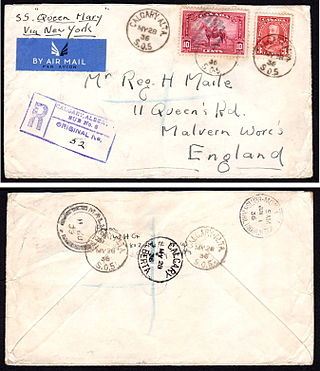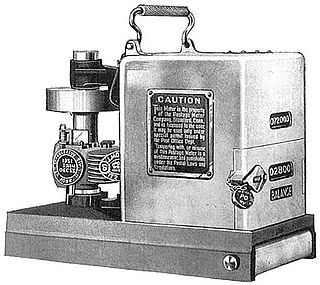
A postmark is a postal marking made on an envelope, parcel, postcard or the like, indicating the place, date and time that the item was delivered into the care of a postal service, or sometimes indicating where and when received or in transit. Modern postmarks are often applied simultaneously with the cancellation or killer that marks postage stamps as having been used. Sometimes a postmark alone is used to cancel stamps, and the two terms are often used interchangeably. Postmarks may be applied by handstamp or machine, using methods such as rollers or inkjets, while digital postmarks are a recent innovation.

The United States Postal Service (USPS), also known as the Post Office, U.S. Mail, or Postal Service, is an independent agency of the executive branch of the United States federal government responsible for providing postal service in the U.S., its insular areas, and its associated states. It is one of the few government agencies explicitly authorized by the Constitution of the United States. The USPS, as of 2021, has 516,636 career employees and 136,531 non-career employees.

A ZIP Code is a system of postal codes used by the United States Postal Service (USPS). The term ZIP was chosen to suggest that the mail travels more efficiently and quickly when senders use the code in the postal address.

An envelope is a common packaging item, usually made of thin, flat material. It is designed to contain a flat object, such as a letter or card.

A postal marking is any kind of annotation applied to a letter by a postal service. The most common types are postmarks and cancellations; almost every letter will have those. Less common types include forwarding addresses, routing annotations, warnings, postage due notices and explanations, such as for damaged or delayed mail and censored or inspected mail. A key part of postal history is the identification of postal markings, their purpose, and period of use.

Registered mail is a mail service offered by postal services in many countries which allows the sender proof of mailing via a mailing receipt and, upon request, electronic verification that an article was delivered or that a delivery attempt was made. Depending on the country, additional services may also be available, such as:
Franking comprises all devices, markings, or combinations thereof ("franks") applied to mails of any class which qualifies them to be postally serviced. Types of franks include uncanceled and precanceled postage stamps, impressions applied via postage meter, official use "Penalty" franks, Business Reply Mail (BRM), and other permit Imprints (Indicia), manuscript and facsimile "franking privilege" signatures, "soldier's mail" markings, and any other forms authorized by the 192 postal administrations that are members of the Universal Postal Union.
In a postal system, a delivery point is a single mailbox or other place at which mail is delivered. It differs from a street address, in that each address may have several delivery points, such as an apartment, office department, or other room. Such buildings are often called multiple-dwelling units (MDUs) by the USPS.

A personalised (or personalized) stamp is a postage stamp on which, for a fee, an image and/or text of the purchaser's choosing may be placed. The stamps vary from country to country, and while some are normal stamps with a personalised label on the left attached by perforations, elsewhere the stamps are more properly regarded as one-piece personalised meter stamps with a colourful design next to the indicia. Stamps produced by Zazzle.com for the United States, for instance, are one-piece, self-adhesive with die cut margins to emulate perforations, and visually very similar to normal United States postage stamps, except for the addition of an information-based indicia (IBI) encoded by little black and white squares along one edge. A serial number appears next to the IBI.

The system for mail delivery in the United States has developed with the nation. Rates were based on the distance between sender and receiver in the early years of the nation. In the middle of the 19th century, rates stabilized to one price regardless of distance. Rates were relatively unchanged until 1968, when the price was increased every few years by a small amount. Comparing the increases with a price index, the price of a first class stamp has been steady. The seal of the Post Office Department showed a man on a running horse, even as railroads and, later, motorized trucks and airplanes moved mail. In 1971, the Post Office became the United States Postal Service, with rates set by the Postal Regulatory Commission, with some oversight by Congress. Air mail became standard in 1975. In the 21st century, prices were segmented to match the sorting machinery in use; non-standard letters required slightly higher postage.

A postage meter or franking machine is a mechanical device used to create and apply physical evidence of postage to mailed items. Postage meters are regulated by a country's postal authority. A postage meter imprints an amount of postage, functioning as a postage stamp, a cancellation and a dated postmark all in one. The meter stamp serves as proof of payment and eliminates the need for adhesive stamps.

Freepost is a postal service provided by various postal administrations, whereby a person sends mail without affixing postage, and the recipient pays the postage when collecting the mail. Freepost differs from self-addressed stamped envelopes, courtesy reply mail, and metered reply mail in that the recipient of the freepost pays only for those items that are actually received, rather than for all that are distributed. Freepost of preprinted cards issued by businesses is also different from postal stationery sold by postal administrations.

The Facing Identification Mark, or FIM, is a bar code designed by the United States Postal Service to assist in the automated processing of mail. The FIM is a set of vertical bars printed on the envelope or postcard near the upper edge, just to the left of the postage area. The FIM is intended for use primarily on preprinted envelopes and postcards and is applied by the company printing the envelopes or postcards, not by the USPS.
A multiline optical-character reader, or MLOCR, is a type of mail sorting machine that uses optical character recognition (OCR) technology to determine how to route mail through the postal system.
Remote Bar Coding System (RBCS), also called Remote Video Encoding (RVE) is a method used by the United States Postal Service to encode the address of letter-sized mailpieces that are not decipherable by a Multiline Optical Character Reader (MLOCR). When an MLOCR does not recognize a valid address on a letter, it sends an image of the mailpiece to a central RBCS (RVE) site where more sophisticated optical character recognition software is able to interpret many hand-written addresses using neural net and fuzzy logic algorithms. If this does not succeed, human operators visually examine the image and enter the address. In both cases, the data is sent back to the originating mail facility where mailpieces are then automatically matched back up with data through the use of a unique fluorescent barcode printed on the back during initial MLOCR attempt, and receive a POSTNET barcode representing the full address.
In the distribution and logistics of many types of products, track and trace or tracking and tracing concerns a process of determining the current and past locations of a unique item or property. Mass serialization is the process that manufacturers go through to assign and mark each of their products with a unique identifier such as an Electronic Product Code (EPC) for track and trace purposes. The marking or "tagging" of products is usually completed within the manufacturing process through the use of various combinations of human readable or machine readable technologies such as DataMatrix barcodes or RFID.
The Postal Alpha Numeric Encoding Technique (PLANET) barcode was used by the United States Postal Service to identify and track pieces of mail during delivery – the Post Office's "CONFIRM" services. It was fully superseded by Intelligent Mail Barcode by January 28, 2013.

The Intelligent Mail Barcode (IMb) is a 65-bar barcode for use on mail in the United States. The term "Intelligent Mail" refers to services offered by the United States Postal Service for domestic mail delivery. The IM barcode is intended to provide greater information and functionality than its predecessors POSTNET and PLANET. An Intelligent Mail barcode has also been referred to as a One Code Solution and a 4-State Customer Barcode, abbreviated 4CB, 4-CB or USPS4CB. The complete specification can be found in USPS Document USPS-B-3200. It effectively incorporates the routing ZIP Code and tracking information included in previously used postal barcode standards.

Mail sorting refers to the methods by which postal systems determine how and where to route mail for delivery. Once accomplished by hand, mail sorting is now largely automated through the aid of specialized machines. The first widely adopted mail sorting machine was the Transorma, first made operational in Rotterdam in 1930.













